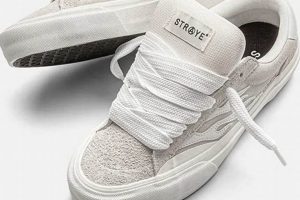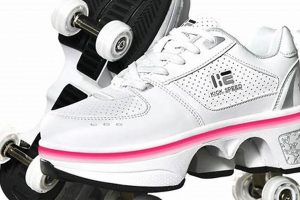Footwear engineered for skateboarding professionals emphasizes durability, performance, and protection. These specialized shoes typically feature reinforced construction, enhanced cushioning, and superior grip to withstand the demands of rigorous skating. The design often includes features such as suede or leather uppers for abrasion resistance, vulcanized rubber soles for board feel, and padded collars for ankle support.
The utilization of appropriate footwear can significantly impact a skater’s ability to execute advanced maneuvers and maintain control. The robust construction and specific design elements provide protection against impacts and abrasions common in skateboarding. Historically, skaters have modified conventional shoes to meet their needs; this ultimately led to the development of specialized footwear addressing those concerns directly. Benefits include improved board feel, reduced risk of injury, and enhanced overall performance.
The following sections will delve into the specific features and materials used in constructing high-performance skateboarding footwear, explore the impact of shoe design on skater technique, and offer considerations for selecting the appropriate model based on individual skating style and needs.
Essential Considerations for Selecting Professional Skateboarding Footwear
Choosing appropriate skateboarding footwear is crucial for performance, safety, and longevity in the sport. These tips offer guidance on selecting models that align with individual needs and skating styles.
Tip 1: Prioritize Durable Uppers: Opt for suede or leather uppers, as these materials offer superior abrasion resistance against grip tape and other surfaces. Reinforced stitching in high-wear areas further enhances durability.
Tip 2: Evaluate Sole Construction: Vulcanized soles provide excellent board feel and flexibility, allowing for precise control. Cupsole construction offers enhanced impact protection for skaters performing high-impact tricks.
Tip 3: Assess Cushioning and Support: Proper cushioning absorbs impact forces, reducing stress on joints. Look for models with integrated cushioning systems in the heel and midsole to minimize risk of injury.
Tip 4: Consider Ankle Support: High-top models provide increased ankle support, which is beneficial for skaters prone to ankle injuries. Mid-top and low-top styles offer greater flexibility and range of motion.
Tip 5: Examine Tread Pattern: A durable tread pattern with sufficient grip is essential for maintaining board control. Look for patterns specifically designed for skateboarding, which often feature enhanced grip in key areas.
Tip 6: Check for Reinforced Areas: Footwear designed for professional use often includes reinforced toe caps and ollie pads to withstand the stress of frequent skateboarding.
Tip 7: Ensure Proper Fit: Ill-fitting footwear can negatively impact performance and increase the risk of blisters and other foot problems. Ensure that the shoe provides a snug, comfortable fit without being too tight.
By carefully considering these factors, skaters can select footwear that optimizes performance, provides adequate protection, and withstands the rigors of the sport.
The following section will explore the specific brands and models that are highly rated and recommended by professional skaters.
1. Durability
The functional lifespan of skateboarding footwear is a paramount consideration, directly correlated to performance and cost-effectiveness. The abrasive nature of skateboard grip tape, coupled with the repetitive impact forces experienced during trick execution, subjects shoes to extreme wear. Consequently, durability is not merely a desirable attribute, but a fundamental requirement for footwear designed for professional skateboarding. Footwear with inadequate resistance to abrasion and impact will fail prematurely, resulting in compromised performance and increased expenditure on replacements.
Manufacturers address this challenge through various design and material choices. Reinforcement in high-wear areas, such as the toe cap and ollie pad, is a common strategy. Employing robust materials like suede or leather, known for their abrasion resistance, is also critical. Furthermore, the integration of durable stitching and resilient sole constructions significantly extends the lifespan of the footwear. For example, vulcanized soles, while offering excellent board feel, require specialized reinforcement techniques to prevent rapid degradation under the stress of repeated landings. Shoes lacking these features are unsuitable for the demands of professional-level skating.
Ultimately, the durability of skateboarding footwear directly influences a skater’s ability to consistently perform and progress. Frequent equipment failure can disrupt training schedules, increase the risk of injury due to compromised shoe integrity, and impose a financial burden on the skater. Investing in footwear specifically engineered for durability, therefore, is a pragmatic choice that contributes to both performance enhancement and long-term cost savings. The trade-offs between factors like board feel and maximum impact protection are also a vital point to consider with the overall durability of the materials, as a more protective shoe often will be more durable in general, but may be less ideal for certain skating styles.
2. Board Feel
Board feel, referring to the sensitivity and connection a skater experiences between their feet and the skateboard, is a crucial performance factor in professional skateboarding. Specialized footwear prioritizes board feel, enabling skaters to execute intricate maneuvers with precision. This sensitivity is influenced by sole thickness, material composition, and shoe construction. Thinner soles, often constructed from vulcanized rubber, provide a closer contact point with the board’s surface, facilitating nuanced adjustments and control. The selection of specific materials further enhances this connection. For example, flexible midsoles and minimalist padding allow for greater tactile feedback, improving a skater’s ability to perceive the board’s position and movement.
The impact of board feel is evident in various skating disciplines. Street skaters often favor shoes with exceptional board feel for performing technical tricks on rails and ledges, requiring minute adjustments to maintain balance and control. Transition skaters, executing fluid movements in bowls and ramps, benefit from footwear that transmits precise information about the board’s interaction with the surface. A lack of adequate board feel can result in missed tricks, decreased control, and an increased risk of injury. The connection between footwear design and skating performance is thus direct and consequential. Shoe manufacturers conduct ongoing research to optimize board feel while also balancing factors such as durability and impact protection.
Understanding the relationship between board feel and professional-grade skateboarding footwear is essential for both skaters and manufacturers. Optimizing this connection leads to enhanced performance, improved control, and greater confidence. However, achieving the ideal balance between board feel and other critical attributes, such as impact protection and durability, remains an ongoing challenge. The pursuit of increasingly refined skateboarding footwear reflects a commitment to advancing the sport through technological innovation and a deep understanding of the skater’s needs.
3. Impact Protection
Impact protection in skateboarding footwear is a critical feature, directly influencing a skater’s safety and performance capabilities. Landing complex tricks generates significant force, necessitating specialized shoe designs to mitigate potential injuries. Professional-grade skateboarding shoes incorporate various technologies to address these impact forces, ensuring skaters can push their limits with a reduced risk of harm.
- Cushioning Technologies
Advanced cushioning systems, often utilizing materials like polyurethane or EVA foam, are integral to impact absorption. These materials dissipate energy upon impact, reducing stress on joints and minimizing the risk of injuries such as heel bruises or ankle sprains. High-end skateboarding shoes integrate these technologies strategically, targeting areas that experience the greatest impact during landings.
- Sole Construction
The construction of the sole plays a significant role in impact protection. Cupsole designs, characterized by a thicker, more structured sole, offer enhanced impact absorption compared to traditional vulcanized soles. While vulcanized soles prioritize board feel, cupsole designs provide a more substantial barrier against ground impact, making them suitable for skaters performing high-impact maneuvers.
- Reinforced Heel and Ankle Support
The heel and ankle are particularly vulnerable to injury during landings. Professional skateboarding shoes often feature reinforced heel counters and padded ankle collars to provide additional support and protection. These features help stabilize the foot and ankle upon impact, reducing the likelihood of sprains and other injuries.
- Energy-Returning Materials
Some skateboarding shoe manufacturers incorporate energy-returning materials into their designs. These materials absorb impact energy and then release it, providing a responsive feel and reducing fatigue. By minimizing energy loss during landings, these technologies can help skaters maintain performance levels over extended sessions.
The integration of impact protection technologies is a defining characteristic of high-performance skateboarding footwear. While board feel and durability remain essential considerations, the ability to mitigate impact forces is paramount for skaters pushing the boundaries of the sport. Selecting footwear that prioritizes impact protection is a proactive measure, safeguarding skaters against potential injuries and enabling them to progress with confidence. The advancements in cushioning systems, sole construction, and supportive elements all contribute to the enhancement of impact protection.
4. Ankle Support
Ankle support constitutes a critical design element in professional skateboarding footwear, directly impacting performance, injury prevention, and overall stability during complex maneuvers. The repetitive stress and high-impact nature of skateboarding place significant demands on the ankle joint, necessitating specialized shoe features to provide adequate support and minimize the risk of sprains or other injuries.
- High-Top vs. Low-Top Designs
The height of the shoe collar significantly influences ankle support. High-top designs extend above the ankle joint, providing increased stability and limiting excessive range of motion. This is particularly beneficial for skaters prone to ankle injuries or those engaged in high-impact activities. Low-top designs, conversely, offer greater flexibility and range of motion, potentially sacrificing some ankle support for enhanced board feel and freedom of movement.
- Padded Collar Construction
The padding around the ankle collar directly contributes to both comfort and support. Denser, more robust padding provides greater cushioning and stability, helping to prevent ankle roll during landings and other high-stress situations. The type of foam used and the collar’s overall design affect the level of support offered.
- Heel Counter Reinforcement
The heel counter, located at the rear of the shoe, provides structural support to the heel and ankle. A reinforced heel counter enhances stability and helps maintain proper alignment, reducing the risk of ankle sprains. Professional skateboarding footwear often incorporates rigid or semi-rigid heel counters to maximize ankle support.
- Internal Support Structures
Beyond the visible features, internal support structures play a crucial role. These structures, often constructed from durable materials like nylon or reinforced textiles, provide additional stability and prevent the shoe from collapsing under stress. These internal components work in conjunction with the external features to offer comprehensive ankle support.
The integration of appropriate ankle support features into professional skateboarding footwear reflects a commitment to both performance enhancement and injury prevention. Skaters must carefully consider their individual needs and skating style when selecting footwear, balancing the desire for flexibility and board feel with the necessity for adequate ankle protection. The advancements in shoe design and material science continue to refine the relationship between ankle support and the demands of professional-level skateboarding.
5. Grip
In the realm of professional skateboarding, tractionor “grip”is a non-negotiable performance element inextricably linked to specialized footwear. This connection transcends mere adherence, influencing board control, trick execution, and overall skater safety.
- Sole Material Composition
The outsole of specialized skateboarding footwear typically utilizes vulcanized rubber, known for its pliable yet durable characteristics. The specific rubber compounds employed are often proprietary blends, engineered to maximize adherence to the skateboard’s grip tape. These compounds balance grip with abrasion resistance, ensuring longevity despite the constant friction. Failure to utilize appropriate rubber results in reduced board control and premature wear.
- Tread Pattern Design
The tread pattern, far from being purely aesthetic, is a critical element in grip optimization. Herringbone, triangular, or variations of geometric patterns are commonly employed to maximize surface contact and channeling of debris, such as small pebbles, away from the contact area. Ineffective tread designs compromise grip, particularly during dynamic maneuvers and varying terrain conditions.
- Surface Area Contact
The area of contact between the sole and the skateboard’s grip tape directly influences traction. Footwear designed for professional skateboarding often features a flatter sole profile to maximize surface contact. Concave or overly sculpted soles reduce the contact area, diminishing grip capabilities. Maintaining a consistent and broad contact patch is essential for stability and control.
- Flexibility and Board Conformity
While a high coefficient of friction is paramount, the sole’s flexibility is also a key factor. A more flexible sole allows the shoe to conform to the concave shape of the skateboard deck, increasing the contact area and enhancing grip. Rigid soles, conversely, limit conformity and reduce the effective grip surface, thereby compromising control.
The interaction between sole material, tread pattern, surface area, and flexibility collectively determines the effectiveness of grip in skateboarding footwear. These factors are meticulously considered in the design and manufacturing process, reflecting the critical importance of traction in professional-level performance. Deviations from these principles directly impact a skater’s ability to execute maneuvers and maintain control, underscoring the intricate relationship between grip and specialized footwear.
6. Material
The selection of materials is paramount in constructing professional skateboarding footwear, directly influencing durability, performance, and skater safety. Each component, from the upper to the sole, requires careful material consideration to withstand the rigorous demands of skateboarding. Suede and leather are commonly employed for uppers due to their abrasion resistance against grip tape, while reinforced stitching minimizes tearing. The choice of materials thus has a direct causal relationship with the shoe’s lifespan and ability to withstand the wear and tear inherent in the sport.
The sole’s material dictates board feel and grip, both critical for control and execution of tricks. Vulcanized rubber, a staple in skateboarding footwear, provides a flexible yet durable bond to the upper and offers excellent grip. The density and composition of the rubber impact the skater’s sensitivity to the board, enabling subtle adjustments and precise maneuvers. For instance, a thicker, more rigid rubber may offer increased impact protection but reduce board feel, while a thinner, softer rubber enhances board feel at the expense of durability. The importance of the right material choice is exemplified by the continued refinement of rubber compounds to balance these competing needs.
Ultimately, the materials utilized in skateboarding footwear are not merely components but rather integral elements that determine the shoe’s functionality and suitability for professional use. Challenges persist in identifying materials that offer the optimal balance of durability, board feel, impact protection, and grip. Ongoing research and development efforts, driven by the demands of professional skaters, continue to push the boundaries of material science in the pursuit of higher performance skateboarding footwear, linking material innovation directly to the progression of the sport.
Frequently Asked Questions
This section addresses common inquiries regarding specialized footwear for skateboarding, providing concise and informative answers.
Question 1: What defines footwear as being specifically designed for professional skateboarding?
Professional skateboarding footwear is characterized by enhanced durability, impact protection, board feel, and grip, achieved through specialized materials and construction techniques. These features cater to the rigorous demands of professional-level skating.
Question 2: How does the sole construction affect the performance of skateboarding footwear?
Sole construction significantly influences board feel and impact protection. Vulcanized soles offer enhanced board feel and flexibility, while cupsole designs provide superior impact absorption.
Question 3: What materials are commonly used in the uppers of professional skateboarding footwear, and why?
Suede and leather are frequently used for uppers due to their abrasion resistance, protecting against wear from grip tape. Reinforced stitching further enhances durability in high-stress areas.
Question 4: Why is ankle support a crucial consideration in skateboarding footwear selection?
Ankle support minimizes the risk of sprains and injuries during landings and complex maneuvers. High-top designs and padded collars offer increased stability and protection.
Question 5: How do tread patterns impact the functionality of skateboarding footwear?
Tread patterns are engineered to maximize grip and board control. Specialized designs enhance surface contact and channel debris, ensuring optimal traction.
Question 6: Is there a trade-off between board feel and impact protection in skateboarding footwear?
Yes, a balance must be struck between these two elements. Thinner soles offer enhanced board feel but reduced impact protection, while thicker soles provide greater cushioning at the expense of board feel.
In summary, professional skateboarding footwear incorporates specific design elements and materials to enhance performance, protection, and durability, catering to the needs of experienced skaters.
The subsequent section will delve into specific brands and models renowned for their superior performance and quality in the skateboarding world.
Conclusion
This exploration has detailed the multifaceted characteristics defining pro skate shoes. The analysis encompassed critical aspects such as durability, board feel, impact protection, ankle support, grip, and material composition. Each element contributes significantly to the overall performance and safety of the footwear within the demanding context of professional skateboarding.
The appropriate selection of skateboarding-specific footwear is not merely a matter of preference, but a strategic decision impacting both performance capability and injury mitigation. As the sport continues to evolve, ongoing innovation in shoe design and material science remains essential for addressing the escalating demands of professional skateboarding.







![Best Slip Skate Shoes: Styles & Performance [Guide] Learn to Surf & Skate: A Beginner's Step-by-Step Guide Best Slip Skate Shoes: Styles & Performance [Guide] | Learn to Surf & Skate: A Beginner's Step-by-Step Guide](https://universitysurfandskate.com/wp-content/uploads/2025/12/th-797-300x200.jpg)